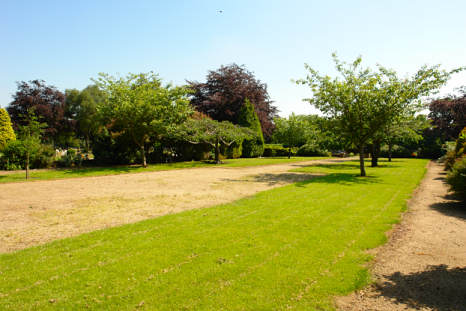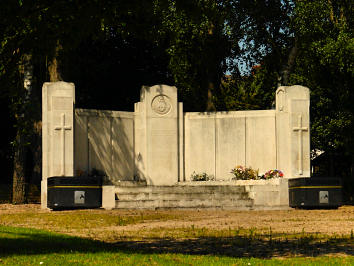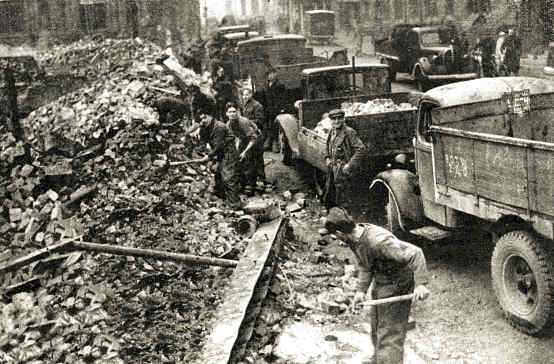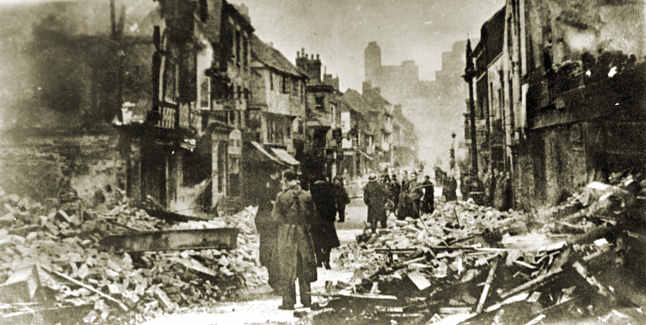|
Index...
|

 fter all the dramatic events, from which the citizens of Coventry were still reeling, the future rebuilding of the town was, for the time being, one of the last things to occupy their minds. Before they could continue with their lives, the people had to say goodbye to their dead - well over five hundred of them.
fter all the dramatic events, from which the citizens of Coventry were still reeling, the future rebuilding of the town was, for the time being, one of the last things to occupy their minds. Before they could continue with their lives, the people had to say goodbye to their dead - well over five hundred of them.
Before the raid, the government had instructed Coventry to cater for 800 casualties, and a mortuary was subsequently made near the gas works (in Gas Street) to hold 500 bodies - an astonishingly accurate figure.
It was obvious from the start that with such a high number of deaths in such a short space of time, hundreds of private burials would prove a huge burden on time and resources. After much deliberation about the popularity of such a thing, it was decided that Coventry was to be the first city of the war to hold a mass funeral.
There were several practical reasons for such a burial, not least of which was that the cost was paid for by the government, and wasn't a burden on each family. Another advantage of the mass burial was that it overcame the worrying problem of identifying individuals.

The first of these funerals was held on Wednesday 20th November, and the first 172 blitz victims were buried that day. By this time, not all the dead from the raid had yet been discovered, and on Saturday 23rd, 250 more were buried in the second mass funeral at the London Road Cemetery.

The photograph below shows what a huge task the clearance was in just one small area around Palace Yard, opposite the Council House. From this image, it can easily be imagined how so many casualties were never accounted for, and some were still being discovered weeks later.


 s the colossal task of clearance got underway, all sorts of unforeseen problems started to come to light. As already discussed, the gas mains was badly damaged, but repairs to this were severely hampered by the fact that all the gas records, plans and maps, which were kept at the old gas works, were also destroyed.
s the colossal task of clearance got underway, all sorts of unforeseen problems started to come to light. As already discussed, the gas mains was badly damaged, but repairs to this were severely hampered by the fact that all the gas records, plans and maps, which were kept at the old gas works, were also destroyed.
No segment of Coventry's infrastructure or social structure remained untouched by the blitz. Factories, hospitals, schools, railways, churches and shops were all deeply affected, and everyone had to 'muck in' with the task of recovery. Even the pupils of King Henry VIII school had some 'lessons' dedicated to the filling in of bomb craters!
Gulson Library was also badly damaged, and to the dismay of future historians, thousands of books and historical records were destroyed in the fire.
Shopping also became extremely difficult. So many shops were lost in the raid, that not only were provisions in short supply, but finding a place to sell them from at that cold time of the year provided a large headache. Hundreds of temporary structures were erected, and vendors went about the task of selling their wares again with gusto - including some defiant signage warning Hitler that we were not beaten!
But above all, housing was the greatest challenge, and tens of thousands of inhabitants had to spend the coming months living wherever they could find a bed. Many stayed outside the city with relatives or even strangers, who let out rooms to homeless families for very low rent. Others shared houses within Coventry, while the owners patiently waited for their 'guests' to return to repaired homes. It must have been an extremely testing time for everybody, but there was plenty to occupy their minds - after all, there was a war on!

This is your first visit to my website today, thank you!
3,149,670Website by Rob Orland © 2002 to 2024